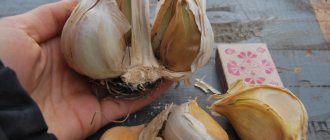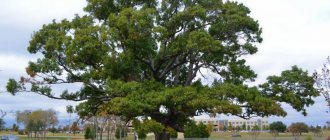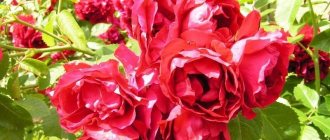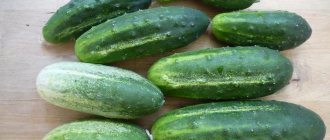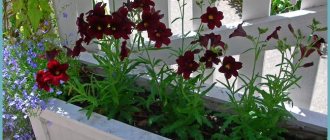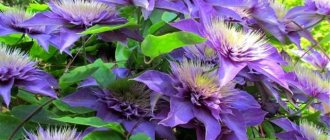Hello, dear friends!
Let's talk today about the imperial hazel grouse
, about this luxurious and majestic flower. This is the real emperor of the spring garden.
I saw him for the first time in Anapa and he immediately captivated me with his unusualness and splendor.
Imperial hazel grouse
they looked like miniature trees, strewn with large flowers and so beautiful that it was impossible to take your eyes off them! And, of course, I immediately decided that they should grow on my summer cottage.
Now I’ll tell you in more detail about what I learned about this plant. Imperial hazel grouse
(or fritillaria) are native to the Eastern Himalayas, the mountains of Iran and Afghanistan.
They came to Europe (first to Italy) and became known in 1553. Then, at the beginning of the 18th century, imperial hazel grouse reached Holland.
Since 1746, 12 varieties of this plant have become known with white, yellow, red, orange flowers, with double the number of flowers in one inflorescence.
Little has changed since then in their appearance and, therefore, some varieties are of historical value.
It’s even hard to believe, but we see the same plants here that the Italians saw four centuries ago. This is incredible!
Varieties as artifacts
The color of varietal flowers of the imperial hazel grouse is quite diverse, but still does not go beyond the red-orange-yellow range.
Therefore, keep in mind that varieties with blue, black, pink, and purple colors do not exist, and if such varieties are offered to you at flower stands, then such pictures are a common photo montage and deception of buyers. Be careful when buying bulbs!
I will describe the varieties of imperial hazel grouse that I planted:
"Imperial Raddeana"
- this hazel grouse is the best in terms of hardiness in the most extreme conditions, with creamy yellow, large, bell-shaped, drooping flowers, which are collected 2-7 in a racemose inflorescence and bloom for 14-16 days;
"Imperial Rubra"
- this imperial hazel grouse is the shortest, its height very rarely exceeds 60 cm, with red brick-colored flowers and crimson streaks inside, the petals of which with faint veins reach a size of 6.5 cm by 4 cm;
"Strip Beauty"
- this hazel grouse blooms from late April to early May for a whole month, with huge bell-shaped flowers of golden color with pronounced red stripes both outside and inside the petals;
"Imperial Lutea"
- hazel grouse with beautiful large yellow flowers of 5-8 pieces in an inflorescence, nectarines are surrounded by a white border turning into green and then purple;
"Imperial Garland Star"
— this hazel grouse has a strong, stable stem and much more flowers than all other varieties; they are large, forming a luxurious crown of bright orange color.
Features of flowering
The color of hazel grouse petals, depending on the variety, can be orange, yellow, brown-red. As a rule, the inflorescence contains six downward-facing bells, the diameter of which can reach 10 and the length of 5 cm. Now there are varieties in which the buds are arranged not in one, but in two rows.
The petals of orange and reddish-brown flowers along the midrib, as well as on the outside at the base, quite often have small “strokes” of a rich burgundy color. A few days after opening, the flowers begin to spread apart. In the first summer month, the royal crown (flower) forms hexagonal fruits, similar in size to flowers - boxes filled with seeds. As they ripen, the seed pods crack, but the seeds do not scatter, since the fruits are directed upward.
Reproduction methods
Hazel grouse are mainly propagated by dividing the bulbs, but it is also possible by seeds. Propagation by seeds is not very popular, especially among amateur gardeners, since in this case we will have to wait about 7 years for the first flowering.
The seed propagation method is acceptable only for those who are engaged in industrial breeding of these flowers, because this way you can get quite a lot of planting material.
During vegetative propagation, large bulbs are divided into two almost every year, while they produce babies much less often and their number is insignificant.
Hazel grouse bulbs must be dug up very carefully and very carefully so as not to damage the bulbs, and most importantly, find the baby, which is small and hard to see in the ground.
Grouse bulbs should not be dried out, and it is better to plant them soon after digging and always immediately after purchase.
Hunting hazel grouse with decoy
In addition to other methods of hunting hazel grouse, hazel grouse are also caught using decoy (otherwise known as pika). Hunting hazel grouse with decoy is one of the varieties of sport hunting for them. The main key to successful hunting for hazel grouse is the ability to imitate the voice of a hazel grouse, be it male or female. But since every single one of the hazel grouse has a keen ear, it doesn’t cost them anything to catch the falseness in the voice and immediately suspect something is wrong. The art of using decoy can be mastered not in one or two attempts, but as a result of hard work. Hunting hazel grouse with decoy is especially popular in September and late August. In this case, the hunter who made the sound must first wait for the return whistle, after which he must disguise himself and only then blow the decoy again, calling the hazel grouse to him
When hunting grouse with a decoy, the most important rule is that the shooter must spot the grouse first before it spots the man. This is followed by a targeted shot and a search for new prey using a decoy
Hunting for corncrakeHunting for wild pigeons Coot is a frequent object of sport huntingHunting for wading birds: snipe Basic methods and principles of hunting a goose The most common breeds of hunting dogs
Attitude towards patients. We need your opinions.
Today, while reading a friend’s feed, I stumbled over a post by a person I’ve known personally for quite some time. The story was that the author of the magazine had a friend who was seriously ill. I understand that this is a tumor... Read more →
Landing area
The place for planting this royal flower must be chosen to be warm, semi-shaded and, to be sure, there are no drafts.
The soil should be loose and fairly fertile. If the soil in your area is heavy, then drainage is necessary, since hazel grouse cannot tolerate excessive waterlogging.
It is best to use river sand as a leavening agent, as well as humus, which will also be a good fertilizer (10-15 kg/m2). We plant the bulbs in early autumn, immediately after new roots appear (if we have our own planting material) or immediately after purchasing the bulbs in the store.
The distance between adult bulbs should be at least 25-30 cm, and the depth at which we plant large bulbs is about 20-30 cm, smaller ones - 13-20 cm and children - 6-10 cm.
Plantings must be covered for the winter.
We take proper care
Imperial hazel grouse is a fairly frost-resistant plant. Adult bulbs rarely freeze out if all the rules of agricultural technology are followed correctly, but still, in winters with little snow, it is advisable to cover them with straw or spruce branches.
The thickness of the covering layer should be about 25-30 cm, and in early spring you must remember to remove the covering in a timely manner so that it does not interfere with seedlings. Young shoots of hazel grouse tolerate spring frosts well, even down to minus 6 degrees.
On cold, frosty mornings, the stems of the hazel grouse freeze and bend towards the ground, but as soon as the sun comes out the plant comes to life and straightens up. Thanks to the strong stem, adult plants do not need tying up. It is necessary to loosen the soil around the hazel grouse very carefully, due to the fact that their roots are often located near the surface of the soil.
Therefore, it is better not to loosen unless absolutely necessary.
Imperial hazel grouse love feeding, but not foliar feeding with a concentrated solution, since such feeding can cause burns to the leaves.
Complex mineral fertilizers are suitable for fertilizing, which must be applied according to the standard scheme indicated on the package.
When to dig?
It is best to dig up the bulbs when the aboveground part of the plant begins to turn yellow and dry out, this is somewhere in the middle - end of June.
There is no need to delay harvesting and wait until the stem dries completely. If we delay this process even for 1-2 weeks, we can destroy the plants. And moreover, the largest bulbs of rare varieties rot first.
Those bulbs that are smaller and grown from babies or seeds are more viable and, although they can tolerate a delay in harvesting, it is also better to dig them up annually. Based on this, it is recommended not to leave hazel grouse in one place for 2-3 years without digging it up. But still, many gardeners advise not to dig up hazel grouse bulbs every year and allow them to be grown for up to 3 years without digging. I will definitely do this experiment.
We must also remember that during the dormant period (summer months) many bulbous plants are easily affected by diseases and pests.
After we have dug up the bulbs, we must carefully inspect them, remove dry films from them, wash them in a warm solution of potassium permanganate, and then dry them.
If rot is discovered during inspection, then it must be carefully scraped off with a dull, clean knife to healthy tissue.
Then disinfect the wounds with iodine or brilliant green. After this, dry the treated onion at high temperature.
Rot can appear during storage on healthy bulbs, so be sure to inspect the planting material every week.
And when buying, I advise you to carefully inspect the hazel grouse so as not to buy low-quality bulbs.
Hazel grouse Radde
Radde's hazel grouse (F. raddeana) is endemic to the Kopetdag. It grows on loose rocky-fine earth slopes and on leveled plateaus with well-developed humus soils. It can be found among bushes at an altitude of up to 1400 m above sea level.
The plant is very beautiful. At the beginning of the 20th century. Attempts were made to grow it in the St. Petersburg Botanical Garden, as well as in botanical gardens in Germany and Holland. In the 1930s, Radde's hazel grouse began to be cultivated in the Central Botanical Garden of the Academy of Sciences of the TSSR. Currently, it can be seen in a number of botanical gardens in our country.
Its high merits attracted the attention of flower growers in England, Czechoslovakia, and Denmark to the Radda hazel grouse.
This is a perennial herbaceous plant with a large spherical bulb and a tall, leafy stem in the middle part. The leaves are sessile, alternate or almost whorled, glossy, light green. Their length is 10 - 15 cm. The flowers are pale yellow, drooping, broadly bell-shaped, large. Their diameter is 4 - 5 cm. They are collected in an apical multi-flowered inflorescence, above which a plume of linear-lanceolate leaves rises. The fruit is a hexagonal capsule with numerous seeds.
In the conditions of Ashgabat, Radde's hazel grouse grows for three months, starting in mid-February. Buds appear in the second half of February, and the first flowers appear in early March. Mass flowering is observed in mid-March. One plant blooms for 15 - 20 days. Seeds ripen in late April - early May. Under cultural conditions, the development rhythm of Radde's hazel grouse remains virtually unchanged compared to plants found in nature. At the end of May, their above-ground part dries out completely, even if the soil contains a sufficient supply of moisture.
The plant successfully propagates by seeds, which should be sown in September - October. The depth of embedding in the soil is 2 - 3 cm. Before sowing, the beds are flooded with water from a ditch network. Friendly shoots appear in February - March. They tolerate short-term frosts well, reaching minus 5 - 7 ° C. In the phase of cotyledon leaves, the seedlings are thinned, leaving a distance of 10 - 12 cm between them. During the summer dormancy period, the seedlings do not need to be watered; they grow slowly, blooming only in the seventh year of life. For this reason, vegetative propagation by bulbs is preferred. Plants grown from bulbs sometimes bloom in the first year of life. The best time to transplant bulbs is during the summer dormancy period.
When cultivated in Ashgabat, Radde's hazel grouse greatly changes its appearance: the plants become taller, reaching a height of 80 - 90 cm (in nature 50 - 70 cm). The size of flowers and fruits almost doubles. The bulbs become significantly larger. Radde hazel grouse can be cultivated in Turkmenistan. It can be used to decorate rocky areas of the garden, open slopes, lawns and lawns.
Part of the natural thickets of the plant is protected in the Syunt-Khasardag Nature Reserve,
Another narrowly endemic Talysh species, the grandiflora hazel grouse (Fritillaria grandiflora), is listed in the Red Book of the USSR. This is a very rare, exclusively decorative, interesting plant from a biological point of view.
How to save?
Before planting, it is best to store imperial hazel grouse bulbs in a warm, dry and preferably ventilated area so that the daytime temperature does not exceed 30-35°C.
Since we dug up the bulbs in June, the storage period will be short.
At the end of August, hazel grouse bulbs begin to develop new roots and a sprout next to the old stem. And very large bulbs can form two sprouts at once.
By the time of planting, the bulbs usually grow quite long roots, which we don’t have to stand on ceremony with at the moment.
Even if we damage them a little when planting, the remaining part of the root thickens and, most importantly, the root begins to branch.
But if you are late with planting, then you need to treat the roots with care and carefully lay them out on the sides when planting, since they no longer have time to recover.
Using the tips from this article, it is not so difficult to grow imperial hazel grouse in your garden and in a year you will enjoy the magnificent and lush flowering of these royal fritillaries.
Botanical description
The imperial hazel grouse is native to the mountainous regions of East Asia, where it was discovered by Italian scientists in the mid-16th century.
The Imperial Fritillary flower, a photo of which is given in this article, has spherical bulbs up to 10 cm in diameter and emits a pungent odor that garden pests (moles, mice and shrews) cannot tolerate. The leaves of the plant are lanceolate, located on the stem in 3-4 whorls. The inflorescences are umbrella-shaped, solitary, each with 20 bracts. The stem is very durable. A group of flowers looks beautiful on it, and additional leaves grow above. They are arranged in a circle, resembling a crown.
As can be seen in the photo, the Imperial Fritillary flower has a perianth shaped like a bell up to 5.5 cm long. The color depends on the variety: yellow, red or orange. Bright flowers grow from leaf axils along the stem; the largest buds form groups of 5-7 pieces. Interestingly, the flowers do not form at the ends of the shoots. Leaves continue to grow above them.
The leaves of the flower Imperial Fritillary, a photo of which can be seen in this article, have an elongated shape, a glossy surface and a bright emerald color. They can reach 20 cm in length. In some varieties they are arranged in 2 rows.
Another useful quality
Imperial hazel grouse have another useful quality, although it has not yet been confirmed by scientific research.
Due to the specific smell of the bulbs, hazel grouse can be used as a means of repelling moles and mole crickets from our site.
And although there is no scientific basis for these statements yet (or simply has not been found), personal experience of summer residents shows that the mole leaves the summer cottage after several bulbs of imperial hazel grouse are planted directly in the mole exits.
At the same time, the bulbs of lilies, tulips and other flowers growing nearby are also preserved without damage.
This is my second year of growing imperial hazel grouse, and if this statement is confirmed, I will plant them throughout my summer cottage, since I have a lot of problems with moles and mole crickets.
This solution to the problem would suit me very much, firstly - magnificently flowering hazel grouse decorating the garden plot, and secondly - the absence of pests))))
Dear readers, I am often asked why imperial hazel grouse sometimes do not bloom. There are answers to these questions in the comments, but I would like to invite you to watch a video on this topic.
See you soon, dear friends!
